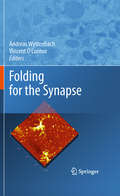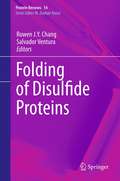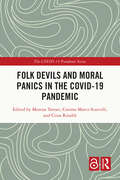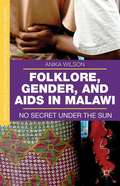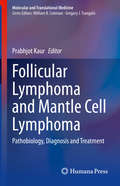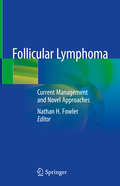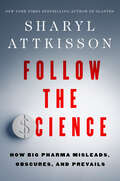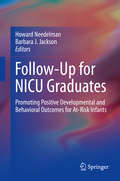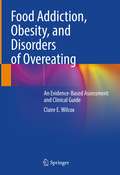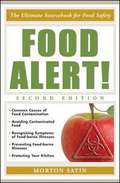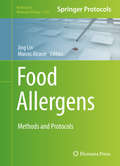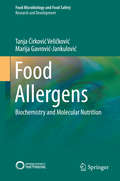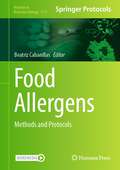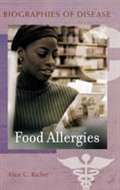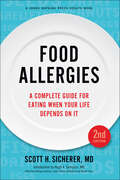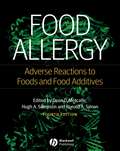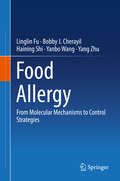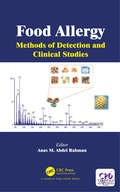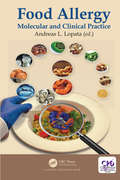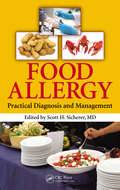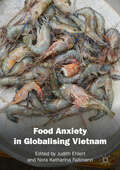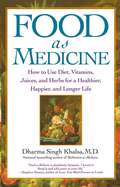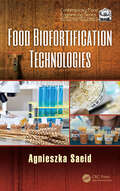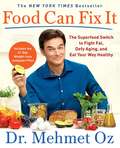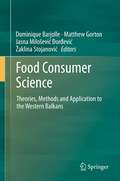- Table View
- List View
Folding for the Synapse
by Andreas Wyttenbach Vincent O'ConnorFolding for the Synapse addresses the current view on how protein folding and misfolding, controlled by molecular chaperones, contribute to synapse function and dysfunction. Molecular chaperones have been studied in relation to de novo protein folding, but there is increasing awareness that chaperone function is required for the regulation of protein dynamics when functioning physiologically as an isolated moiety or part of a protein complex. This book will introduce both important concepts of folding machineries and give examples of the biological relevance of further chaperone functions.
Folding of Disulfide Proteins
by Rowen J. Chang Salvador VenturaThis book aims to cover the knowledge of protein folding accumulated from studies of disulfide-containing proteins, including methodologies, folding pathways, and folding mechanism of numerous extensively characterized disulfide proteins. Folding of Disulfide Proteins will be valuable supplementary reading for general biochemistry, biophysics, molecular biology, and cellular biology courses for graduate and undergraduate students. This book can also be used for specialized graduate-level biochemistry, biophysics, and molecular biology courses dedicated to protein folding as well as related biological problems and diseases. Will also be of interest to everybody interested in problems related to protein folding, and anyone who is interested in understanding the mechanism of protein misfolding and protein misfolding-related diseases.
Folk Devils and Moral Panics in the COVID-19 Pandemic (The COVID-19 Pandemic Series)
by Cosimo Marco Scarcelli Morena Tartari Cirus RinaldiFolk Devils and Moral Panics in the COVID-19 Pandemic analyses the phenomena of moral panics surrounding so-called folk devils in the context of the COVID-19 pandemic.In this volume, internationally recognised moral panic scholars from disciplines including sociology, media studies, criminology, and cultural studies examine case studies of moral panics related to the COVID-19 pandemic. These analyses consider the different social, political, economic, organisational, and cultural contexts within which such moral panics emerged and assess how the concept of moral panic can be deployed to offer novel insights into sociocultural responses to the outbreak. By utilising both classical approaches to moral panic analysis and more recent trends, chapters discuss the utility of the concept of moral panic that is, for the first time, applied to a global-scale event like the COVID-19 pandemic.This volume will be of interest to students and scholars in the social sciences with an interest in moral panics, responses to the COVID-19 pandemic, and the media and popular culture.
Folklore, Gender, And Aids In Malawi
by Anika WilsonInformal folk narrative genres such as gossip, advice, rumor, and urban legends provide a unique lens through which to discern popular formations of gender conflict and AIDS beliefs. This is the first book on AIDS and gender in Africa to draw primarily on such narratives. By exploring tales of love medicine, gossip about romantic rivalries, rumors of mysterious new diseases, marital advice, and stories of rape, among others, it provides rich, personally grounded insights into the everyday struggles of people living in an era marked by social upheaval.
Follicular Lymphoma and Mantle Cell Lymphoma: Pathobiology, Diagnosis and Treatment (Molecular and Translational Medicine)
by Prabhjot KaurThe book is dedicated to Follicular lymphoma and Mantle cell lymphoma and highlights major reference works that contributed significantly to the understanding of these two lymphomas. The aim is to bring the basic science adjacent to the applied science. There is significant focus on the biology of normal B cell development that forms the basis for understanding the pathobiology of these entities. This text is designed to provide a concise yet comprehensive summary of traditional and newer entities, prognostic markers, pathobiology and newer classifications based on molecular genetics/chromosomal abnormalities. The chapters are written by practicing hematopathologists, molecular pathologists, dermatopathologists and clinical haematologists with an emphasis on practical approaches to these entities. The newer technologies and their practical applications are elaborated in an easy-to-comprehend format. Follicular Lymphoma and Mantle Cell Lymphoma is an approachable read for residents and fellows and clinically relevant to practicing pathologists and hematologists. It also serves as a valuable resource for anyone with an interest in B cell lymphomas.
Follicular Lymphoma: Current Management and Novel Approaches
by Nathan H. FowlerThis book provides a comprehensive, state-of-the-art overview of follicular lymphoma. The first section of the text explores the current understanding of the biology and pathogenesis of follicular lymphoma, through reviewing recent changes in the WHO classification of low-grade lymphomas, current diagnostic techniques, and emerging research on the importance of the immune microenvironment. The second section focuses on current treatment for localized disease, advanced stage disease, and transformed follicular lymphomas, and details currently FDA approved regimens and evolving radiation techniques for early stage and advanced disease. The last section of the text presents emerging approaches in targeted, immunologic, and vaccine therapy.Written by experts in the field, Follicular Lymphoma: Current Management and Novel Approaches is a valuable resource for practicing clinicians, practitioners, and researchers who manage and have an interest in follicular lymphoma.
Follow the Science: How Big Pharma Misleads, Obscures, and Prevails
by Sharyl AttkissonEmmy Award-winning investigative journalist and New York Times bestselling author Sharyl Attkisson exposes the corruption that has ruled the pharmaceutical industry for decades.Through blatant lies, deep cover-ups, and high-level collusion with government and media, Big Pharma has continuously put profits over people with dangerous results. Now, with her signature investigative rigor and uncompromising commitment to the facts, Sharyl Attkisson takes readers on an shocking journey through the dark underbelly of the pharmaceutical industry.Follow the Science recounts, in exacting detail, how far the pharmaceutical industry and its supporters in medicine, media, and government will go to protect their profits. Attkisson provides shocking examples that reveal the disturbing callousness our government, public health officials, and top researchers are capable of when it comes to the most vulnerable among us. And she explains, in a graphic sense, how some of the most trusted within our society are willing to commit life-threatening ethics violations. When caught, they circle the wagons and marshal forces to defend their bad acts and take steps to cruelly silence the injured and smear those who would expose them.This book includes exclusive, eye-opening evidence including:Financial ties between well-known vaccine promoters and the vaccine industryOutrageous collusion between the news media and Big PharmaHow Big Pharma teaches slanted information to med students and doctorsGovernment officials secretly admitting vaccines caused some cases of autismThe first child seriously injured by Covid vaccines while in Pfizer's studyThe secretive money backing seemingly independent studies and nonprofitsFollow the Science will challenge your assumptions, open your eyes, and inspire you to take action. With its powerful message of truth and justice, this book is a must-read for anyone who cares about the future of our healthcare system and their own family's health.
Follow-Up for NICU Graduates: Promoting Positive Developmental And Behavioral Outcomes For At-risk Infants
by Barbara J. Jackson Howard NeedelmanThis book examines the role of Neonatal Intensive Care Units (NICUs) and follow-up clinics in addressing the complex developmental, behavioral, social, and medical needs of at-risk infants through early intervention and medical subspecialties. It describes the necessary functional components of follow-up clinics and challenges in establishing and running multidisciplinary clinics in an area of difficult heath care financing. Chapters provide essential guidelines for determining which neonates will need follow-up care, evaluating for neurodevelopmental delays and medical and behavioral impairment and disability, and estimating how long intervention and further follow-up will be required. Chapters also discuss organization, staffing, funding, testing protocols, and coordination with other programs and care facilities, particularly early intervention and the medical home. In addition, the book offers best practices for fostering optimal development for individual infants and high-risk populations while raising standards for neonatal care and creating a smooth transition to appropriate subsequent care. Topics featured in this book include: Developmental care in the nursery. Utilizing neonatal brain imaging to predict neurodevelopmental outcomes of NICU infants.Genetic considerations in infants with congenital anomalies.The HRIF clinic organization model.Issues common in neurodevelopmental testing of premature infants.The impact of environmental risks, such as parental distress and in-utero drug exposure, to infant neurodevelopment. Follow-Up for NICU Graduates is a must-have resource for researchers, practitioners, and graduate students in developmental psychology, pediatrics, neuroscience, obstetrics, nursing, and related disciplines.
Food Addiction, Obesity, and Disorders of Overeating: An Evidence-Based Assessment and Clinical Guide
by Claire E. WilcoxThis book is written for providers of broad training backgrounds, and aims to help those who care for people with EDs, overweight and obesity provide evidence-based care. The goal of the book is to provide these providers with a straightforward resource summarizing the current standard of care. However, it goes further by also introducing the concept of food addiction (FA) as a model to understand some forms of overeating. This book discusses the pros and cons of embracing FA and reviews the evidence for and against the validity and utility of FA. By doing so, the chapters convey a “middle ground” approach to help people with obesity, BED, and bulimia nervosa plus FA symptomatology who also want to lose weight. The text discusses FA by reviewing several of the main ongoing controversies associated with the construct. It reviews both the clinical and neuroscientific evidence that some individuals’ eating behavior mirrors that seen in substance use disorders (SUD), such as how their relationship with food appears to be “addictive”. Chapters also discuss how many of the mechanisms known to underlie SUDs appear to drive overeating in animal models and humans. Finally, the text argues that the similarities between the brain mechanisms of addictive disorders and overeating behavior has the potential to open up new avenues for current treatment and treatment development. Food Addiction, Obesity and Disorders of Overeating: An Evidence-Based Assessment and Clinical Guide is suited for both medical and mental health practitioners, including physicians in primary care or psychiatry, nurses, psychologists, social workers, medical students and medical residents. It could also be utilized by researchers in obesity and ED fields, stimulating ideas for future research and study design.
Food Alert! The Ultimate Sourcebook for Food Safety (2nd edition)
by Morton SatinSatin (agricultural economics, Texas A&M U.; retired, International Food and Agribusiness Management Association) discusses this major health threat in historical, scientific, commercial, consumer, and homeland security contexts. Updates to the 1999 edition include discussions of recent multi-state outbreaks of E. coli and salmonella, prevention initiatives, and the under-reporting of such problems. The text features case examples (e.g., a "bad bucket [of shellfish] off Nantucket"), summary table of food- related disease symptoms and causes, storage recommendations, information resources, and glossary.
Food Allergens
by Jing Lin Marcos AlcocerThis volume provides a collection of methodologies for basic research, clinical diagnosis, and treatment pertaining to food allergens, including food allergen production, purification, characterization, detection, quantification, and bioinformatics approaches to modern food allergen studies. The chapters in the book are divided into 4 parts: Part I discusses food allergen purification and production, and explores methods of producing recombinant food allergens in bacterial and yeast expression systems; Part II looks at allergen discovery, detection, and quantification covering 3 types of methods--DNA-, protein-, and cell-based methods; Part III focuses on allergenic epitope mapping; and Part IV talks about future developments concentrated around new concepts of allergenicity as an outcome of protein and food matrix interactions. Written in the highly successful Methods in Molecular Biology series format, chapters include introductions to their respective topics, lists of the necessary materials and reagents, step-by-step, readily reproducible laboratory protocols, and tips on troubleshooting and avoiding known pitfalls. Cutting-edge and comprehensive, Food Allergens: Methods and Protocols is a valuable resource for immunologists, biochemists, molecular biologists, and medical doctors and students working in the food allergy field. This book is also useful for people in the food industry, legislators, food standard agencies, allergologists, pediatricians, and clinicians in the allergic diseases and immunology fields.
Food Allergens
by Tanja Ćirković Veličković Marija Gavrović-JankulovićA food allergen has the ability to first elicit an IgE response, and then, on subsequent exposures, a clinical response to the same or similar protein. How harmless food protein becomes recognized by the mucosal immune system as an allergen remains an open question and more data are needed to explain how regulatory mechanisms of the mucosal immune system fail and result in allergic sensitization to dietary antigens. Some biochemical characteristics associated with food allergens, such as the presence of multiple, linear IgE-binding epitopes and the resistance of the protein to digestion and processing, seem to predominate among food allergens. Digestion susceptibility of food allergens that sensitize via the gastrointestinal tract and stability to food processing conditions are inherently related to protein structural features. Thereby, physiological changes in the digestion process, pathological conditions affecting digestion, as well as procedures and food processing conditions that affect protein structure may all have a profound effect on the sensitizing potential and allergenicity of food proteins. In addition, signals coming from the diet and micro biome can modulate regulatory mechanisms of the mucosal immune system and influence mucosal immunity and intestinal barrier function. The detection of allergenic ingredients in food products has received increased attention from the food industry and legislative and regulatory agencies over recent years. This has resulted in the improvement of applied safety measures that provide protection for food-allergic consumers and development of sensitive and highly specific analytical methods of food allergens detection. Food allergy is an important and common health issue and therefore there is a need to characterize the sensitizing potential of newly introduced proteins in genetically engineered foods. A combination of in vitro and in silico methods provide information that contributes to safety assessment. Suitable in vivo models may provide a more holistic assessment of allergenic potential of novel food proteins.
Food Allergens: Methods and Protocols (Methods in Molecular Biology #2717)
by Beatriz CabanillasThis detailed volume provides a comprehensive collection of methods and protocols in food allergy and food allergens studies. The selected protocols explore the study of food allergens, from recombinant production, purification procedures, IgE and T cell epitopes characterization, to allergen structure description, cellular responses, and tolerance induction, through a variety of techniques and animal models. Written for the highly successful Methods in Molecular Biology series, chapters include introductions to their respective topics, lists of the necessary materials and reagents, step-by-step and readily reproducible laboratory protocols, as well as tips on troubleshooting and avoiding known pitfalls. Authoritative and practical, Food Allergens: Methods and Protocols serves as an ideal reference for scientists at all stages involved in the study of food allergy and allergenic components.
Food Allergies (Biographies of Disease)
by Alice C. RicherMost people take eating for granted - but for some, eating can be downright dangerous. Thirty thousand Americans are hospitalized each year due to an allergic food reaction and peanut allergies in American children doubled from 1997 to 2002.
Food Allergies: A Complete Guide for Eating When Your Life Depends on It (A Johns Hopkins Press Health Book)
by Scott H. SichererThe essential guide for anyone who suffers from food allergies.Posing the urgent questions that anyone with food allergies will think to ask—and then some—Food Allergies provides practical, sensitive, and scientific guidance on the topics that affect your life. Allergy expert Scott H. Sicherer addresses the full spectrum of food allergies, from mild to life threatening and from single foods to food families, clearing up misconceptions along the way. He explores how exposure to foods can bring about an allergic response, describes the symptoms of food allergy, and illuminates how food allergies develop.Organized in an accessible Q&A format and illustrated with case studies, the book thoroughly explains how to prevent exposure to a known allergen at home, at school, in restaurants, and elsewhere. Dr. Sicherer also gives valuable advice about what to do if exposure occurs, including how to handle an anaphylactic emergency. Finally, he describes tests for diagnosing food allergies and chronic health problems caused by food allergies, such as eczema, hives, and respiratory and gastrointestinal symptoms.In this thoroughly updated new edition, Dr. Sicherer• describes new approaches to prevent food allergies• presents cutting-edge theories on risk factors for developing food allergies• describes innovative allergy tests to improve diagnosis• explains how to administer emergency medications for severe reactions• focuses on new allergens of concern, such as pink peppercorns• analyzes studies suggesting that resolution of an allergy might be predictable• talks about the role of "healthy diet"• lists additional resources, including allergy-related apps• provides revised school food allergy guidelines• offers insights into food allergy bullying—and advice to reduce itDr. Sicherer also reviews food reactions that are not allergic (such as lactose intolerance and celiac disease), advises how to get adequate nutrition when you must avoid dietary staples, and discusses whether allergies ever go away (they do—and sometimes they return).
Food Allergy: Adverse Reactions to Foods and Food Additives (Fourth Edition)
by Dean D. Metcalfe Ronald A. Simon Hugh A. SampsonApplying a scientific approach this unique book covers both pediatric and adult adverse reactions to foods and food additives. Following the successful formula of the previous editions, Food Allergy has established itself asthe comprehensive reference for those treating patients with food allergy or suspected allergy. The book has been thoroughly revised and updated presenting new chapters devoted to food biotechnology and genetic engineering, seafood toxins, future approaches to therapy and hidden food allergens.Food Allergy, fourth edition, is divided into five sections featuring key concept boxes for each chapter. Displayed in a logical manner the book is a practical, readable reference for use in the hospital or private practice setting.
Food Allergy: From Molecular Mechanisms To Control Strategies
by Linglin Fu Bobby J. Cherayil Haining Shi Yanbo Wang Yang ZhuThis book addresses the molecular mechanisms of food allergies and related control strategies. To do so, it covers a broad range of topics, including: the basic immunology of food allergies, including crosstalk between gut mucosal immunity and allergens; types of food allergens, structure of food allergen epitopes and cross-reactivity; detection and quantification methods for food allergens; in vitro and in vivo models for evaluating allergenicity; novel food processing methods for the development of hypoallergenic foods; bioactive natural compounds and functional foods for alleviating allergic reactions; modulation of the microbiota in food allergies and use of probiotics in allergic response regulation; and risk assessment and control strategies for food allergens. <p><p> The information provided will enable food scientists/specialists to design safer and more functional food products, and will help regulatory agencies identify and label food allergens (and thus help consumers avoid allergic reactions). It will help clinicians and public health investigators prevent or treat outbreaks of food allergies, and will provide food producers and processors, as well as government inspectors, with valuable insights into evaluation, risk assessment and control strategies for allergens. Lastly, it will benefit upper-level undergraduate and graduate students in food science and safety, public health, medicine, nutrition and related fields.
Food Allergy: Methods of Detection and Clinical Studies
by Anas RahmanThis book explores the recent advances and integrations in molecular technology in food research platforms, which have revolutionized the way we discover and trace potential allergens in our food and drugs and how we utilize that for diagnosis and management. These different technologies for global allergenomic profiling in different kinds of food are discussed, including mass spectrometry, chromatography, and nuclear magnetic resonance. The book also addresses multiomics research with bioinformatics strategies in food allergy in terms of allergen characterization and quantitation, and covers applications in food allergy research from discovery to routine analysis.
Food Allergy: Molecular and Clinical Practice
by Andreas L. LopataFood allergy is an adverse immunological reaction to allergens present in food. Up to 4% adults and 8% children are affected by food allergy. The increase in allergic diseases to food has led to the need for better diagnostics and more effective therapeutic approaches. This book describes the molecular biology and immunology of major food allergens, from laboratory based science to clinical immunology, encompassing novel characterisation and quantification methods, the application of recombinant food allergens in molecular diagnosis and the development of novel therapeutics. This book is the ideal reference tool for researchers, students and allergy clinicians to accurately diagnose and manage food allergies.
Food Allergy: Practical Diagnosis and Management
by Scott H. SichererFood allergy has increased over the past two decades, with a larger number of patients presenting a myriad of related symptoms and illnesses to physicians and allied health professionals. The growing number of patients poses a challenge to health care providers and confirms the need for developing best clinical practice guidelines. Based on the Exp
Food Anxiety in Globalising Vietnam
by Judith Ehlert Nora Katharina FaltmannThis open access book approaches the anxieties inherent in food consumption and production in Vietnam. The country’s rapid and recent economic integration into global agro-food systems and consumer markets spurred a new quality of food safety concerns, health issues and distrust in food distribution networks that have become increasingly obscured. This edited volume further puts the eating body centre stage by following how gendered body norms, food taboos, power structures and social differentiation shape people’s ambivalent relations with food. It uncovers Vietnam’s trajectories of agricultural modernisation against which consumers and producers manoeuvre amongst food self-sufficiency, security and abundance.Food Anxiety in Globalising Vietnam is explicitly about ‘dangerous’ food – regarding its materiality and meaning. It provides social science perspectives on anxieties related to food and surrounding discourses that travel between the local and the global, the individual and society and into the body. Therefore, the book’s lens of food anxiety matters for social theory and for understanding the embeddedness and discontinuities of food globalizations in Vietnam and beyond. Due to its rich empirical base, methodological approaches and thematic foci, it will appeal to scholars, practitioners and students alike.
Food As Medicine: How to Use Diet, Vitamins, Juices, and Herbs for a
by Guru Dharma KhalsaA holistic approach to healing through making smart food choices by health guru Dr. Dharma Singh Khalsa that combines spiritual advice and integrative medicine to provide healthful recipes and nutrition plans targeting common and chronic illnesses for a longer, healthier, natural life.Did you know that blueberries can increase brain longevity? That kiwi fruit can be an excellent weapon for battling cancer and heart disease? That pears can help prevent fibroid tumors? From the bestselling author of Meditation as Medicine, comes a remarkable book that helps you achieve maximum health by eating well. Grounded in science, Food as Medicine is a pragmatic and accessible reference that sets readers on the right nutritional path. Dr. Khalsa then explains how to use natural organic juices and foods as medicine, and how food can help reverse the progress or diminish the symptoms of certain diseases, such as Alzheimer's and Hepatitis C. Drawing on patient case histories, Food as Medicine outlines the seven principles of "The Khalsa Plan" for healthy eating, details ailment-specific nutritional plans, and lays out dozens of delicious recipes that promote overall well-being. After all, food is not only the original medicine -- it's the best medicine.
Food Biofortification Technologies (Contemporary Food Engineering)
by Agnieszka SaeidBiofortification, which can be defined as the process of increasing the content/density of essential nutrients and/or its bioavailability of food with valuable compounds, is a promising means of increasing nutrient intakes. Traditional fortification practices in which exogenous nutrients are added to food can increase the content of nutrients but the use of biofortified foods with nutrients also may deliver the compounds in a more available form, as well as boost the overall relative effectiveness of these foods in raising nutrients status. Food Biofortification Technologies presents the state of the art in the field of novel methods of fortification and agricultural treatments as a way to improve the quality of obtained food products or compounds enriched with valuable nutrients. The book deals with fortification methods and agricultural treatments, which can improve the quality of food products or other agricultural compounds, providing them with a higher density of valuable nutrients. The utilization of novel products, such as feed additives and fertilizers, can avert nutrients depletion in food products. The book describes new and conventional methods of introducing valuable compounds into food components and presents the application of biosorption, bioaccumulation, and utilization of fertilizers in obtaining designer food. Attention is paid to the use of biomass as the carrier of nutrients such as microelements into the food components. The chapters are dedicated to specific food products and their nutrient components. The first chapter discusses the agronomic biofortification with micronutrients where the fertilization strategies are pointed out as a key to plant/cereals fortification. Other chapters present the fortification of animal foodstuffs such as meat, fish, milk, and eggs as well as the fortification of plant foodstuffs such as vegetables, fruits, and cereals. The book also explores advances in food fortification with vitamins and co-vitamins, essential minerals, essential fatty and amino acids, phytonutrients, and enzymes.
Food Can Fix It: The Superfood Switch to Fight Fat, Defy Aging, and Eat Your Way Healthy
by Mehmet OzIncludes the 21-Day Weight Loss Jumpstart! Improve your life through your diet with a friendly, non-punishing, and completely authoritative approach to harnessing the healing power of food from Dr. Mehmet Oz, America’s #1 authority on health and well-being.What if you had an effortless way to improve your mood, heal your body, lose weight, and feel fantastic? What if a cure for everything from fatigue to stress to chronic pain lay at your fingertips? In his groundbreaking new book, Dr. Oz reveals how every meal, snack, and bite we take holds the solution to our health problems. In a world of endless choices, determining what to eat and when to eat it can seem overwhelming. Fortunately, it doesn’t have to be this way. In Food Can Fix It, Dr. Oz lays out a simple, easy-to-follow blueprint for harnessing the healing power of food. Through simple modifications and a meal plan filled with nutrient-rich superfoods, Dr. Oz explains how to kickstart weight loss, improve your energy, decrease inflammation, and prevent or alleviate a host of other common conditions—all without medication. His plan also includes stress-free, healthy, and delicious recipes and appealing full-color photographs that show just how easy it can be to improve your well-being through the food you eat. Drawing on responses from thousands of readers of The Good Life, Dr. Oz's popular, prize-winning magazine, Food Can Fix It is the ultimate guide to eating for health, and the ticket to living your best life, starting today.
Food Consumer Science
by Dominique Barjolle Jasna Milošević Đorđević Žaklina Stojanović Matthew GortonThis book explores the main methods, models, and approaches of food consumer science applied to six countries of the Western Balkans, illustrating each of these methods with concrete case studies. Research conducted between 2008 and 2011 in the course of the FOCUS-BALKANS project forms an excellent database for exploring recent changes and trends in food consumption.
